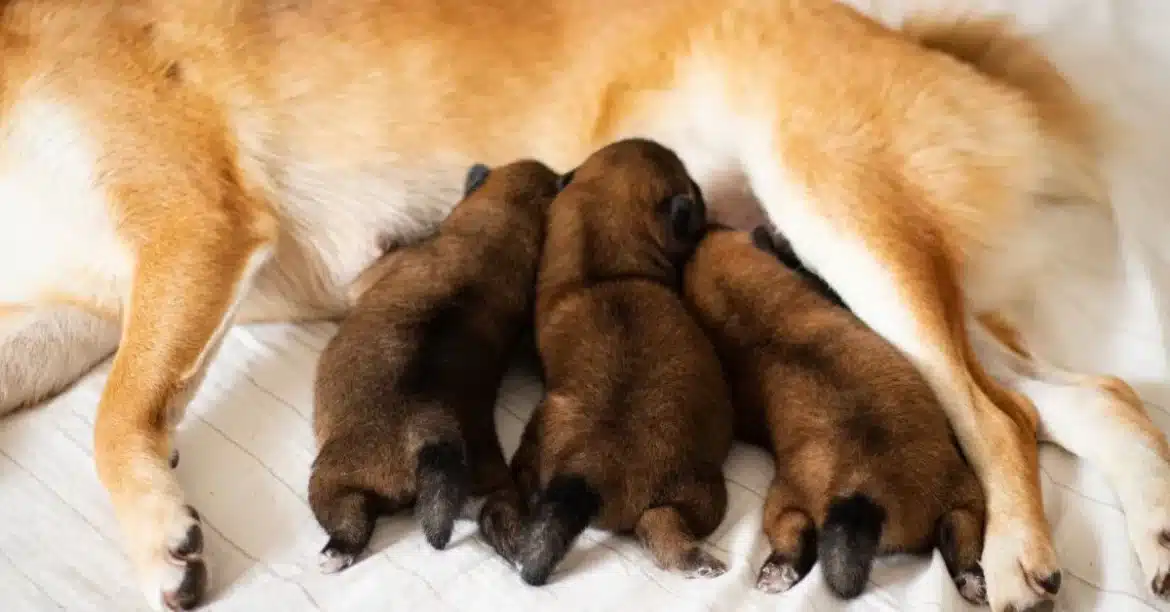A common question we get asked a lot about c section for dogs is “When a dog has a C-section do they have to have a C-section the next time?”
Welcoming a new litter of puppies into the world is an exciting time for any dog owner and dog breeders alike. However, there are instances when your furry friend may need a dog cesarean section, also known as a dog c section, to ensure the safe delivery of her puppies.
In this article, we will explore the ins and outs of a c section in dogs, from when they are necessary to the recovery process for both the mother and her puppies.
Disclaimer: The information provided in this article is for educational purposes only and should not replace professional veterinary advice. Please consult with your veterinarian for personalized guidance regarding your dog’s specific needs and circumstances.
What are the reasons why a dog might need a c-section instead of a natural birth?
Dog pregnancy typically last for 63 days, and, in most cases, the birth process occurs naturally. However, there are certain situations where a C-section for dogs may be recommended or required. These include:
- Abnormally small pelvis: Some dogs may have a pelvis that is too small to allow for a safe natural birth, putting both the mother and puppies at risk.
- Previous C-section: If a dog has previously undergone a C-section, another C-section will likely be necessary for subsequent pregnancies. Hence referred to as an elative c-section.
- Prolonged labor or dystocia: slow dilation or prolonged active labor without progress may warrant an emergency c-section. f a dog has been in labor for an extended period without progress, a C-section may be performed to prevent complications and ensure the well-being of the mother and puppies.
It is important to note that C-sections in dogs are rarely performed as a routine procedure but rather as a necessary intervention to safeguard the health of the mother and her puppies.
How much is a dog C-section?
The cost of a dog C-section can vary widely depending on several factors, including the location, the veterinarian’s experience, the size and breed of the dog, and any additional services or complications that may arise during the procedure.
On average, you might expect to pay between $500 and $2,000 for a routine dog C-section. However, this is a rough estimate, and the actual cost can be higher or lower based on the factors mentioned above.
It’s important to note that emergency C-sections or those performed outside regular business hours may incur additional fees. Additionally, the cost may include pre-operation exams, anesthesia, post-operative care, and other associated services.
Before scheduling a C-section for your dog, it’s advisable to consult with your veterinarian, discuss the specific circumstances surrounding your dog’s pregnancy, and get a detailed estimate of the potential costs involved.
The Cesarean Section Procedure in Dogs
A dog C-section is a surgical procedure that requires a skilled veterinary team to ensure the safety and well-being of the mother and her puppies. Here is a step-by-step overview of what happens during a dog C-section:
- Preparation: Before the surgery, the dog is typically given fluids and electrolytes intravenously to address any dehydration. The veterinarian will also assess the dog’s condition and administer any necessary treatments or medications to stabilize her for the procedure.
- Anesthesia: General anesthesia is administered to the mother dog to ensure her comfort and to minimize stress during the surgery. Local anesthesia, such as an epidural, may also be used to reduce the amount of general anesthesia required.
- Incision: Once the dog is under anesthesia, the veterinarian will make an incision in the lower abdomen, typically from the belly button to the pubis. This allows access to the uterus.
- Delivery of Puppies: The veterinarian will carefully bring the uterus to the surface and make an incision in one uterine horn. The puppies are then gently removed from the uterus, one by one, ensuring that the placentas are also detached.
- Closure: After all the puppies have been safely delivered, the placentas are counted to ensure none remain in the uterus. Each puppy is removed from its sack, and the umbilical cords are clamped and cut. The surgical site is then sutured closed with subcuticular stitching to minimize interference with nursing.
- Recovery: Once the surgery is complete, the mother dog is closely monitored as she wakes up from anesthesia. As soon as she is stable, the puppies are introduced to her to encourage maternal instincts and nursing.
Recovery and Aftercare Tips for a Dog After C Section
Recovery from a dog C-section is a crucial period that requires careful monitoring and attention. Here’s what pet owners should expect during the recovery process:
- Post-Surgery Monitoring: The mother dog will be closely monitored as she recovers from anesthesia. It is essential to watch for signs of complications, such as fever, loss of appetite, swelling, or signs of uterine infection at the incision site.
- Bonding with Puppies: Early bonding between the mother and her puppies is crucial for their well-being. Once the mother is stable, the puppies should be introduced to her, allowing her to nurse and care for them.
- Discharge and Home Care: Depending on the veterinarian’s assessment, the mother dog and her puppies may be discharged from the hospital once they are stable. Pet owners will receive detailed instructions on how to care for the mother and her puppies at home, including any prescribed medications and post-operative care.
- Monitoring Puppies: It is important to closely monitor the puppies’ health and development after a C-section. Watch for signs of proper nursing, weight gain, and normal elimination. If any concerns arise, contact your veterinarian for guidance.
- Follow-up Visits: Follow-up visits with the veterinarian are essential to ensure the mother dog’s incision site is healing properly and to address any potential post-operative complications.
Risks and Complications After Dog C-section
While C-sections in dogs are generally safe procedures, there are potential risks and complications that pet owners should be aware of. These include:
- Anesthesia-related risks: General anesthesia carries certain risks, and the effects on puppies can be more significant. Veterinarians take precautions to minimize these risks, but it is essential to be aware of the potential complications.
- Hemorrhage: Bleeding during or after the surgery is a possibility. In some cases, oxytocin administration or even an ovariohysterectomy (removal of the uterus and ovaries) may be necessary to control bleeding.
- Infection: Infections can occur at the surgical site or within the uterus. Proper post-operative care, including cleanliness and any prescribed antibiotics, can help reduce the risk of infection.
- Puppy health issues: Puppies born via C-section may have an increased risk of certain health issues, such as respiratory problems or difficulties in nursing. Close monitoring and prompt veterinary care can help address these challenges.
When a dog has a C-section do they have to have a C-section the next time?
Pet owners often wonder if a dog can have multiple C-sections. While there is no hard and fast rule, we recommend limiting the number of C-sections a dog undergoes. The exact number of C-sections a dog can have depends on various factors, including her overall health and the specific circumstances of each pregnancy.
Responsible breeders and veterinarians often suggest limiting C-sections to two or three throughout a dog’s lifetime to maintain the mother’s well-being and the health of her puppies. It is crucial to consult with your veterinarian to determine the best course of action for your dog’s specific situation.
Is it possible for a dog to give birth naturally after having a c-section with a previous litter?
Yes, it is possible for a dog to give birth naturally after having a C-section with a previous litter. This process is known as a vaginal birth after cesarean (VBAC) in dogs. However, the feasibility of a successful VBAC depends on various factors, including the reason for the previous C-section, the dog’s overall health, and the presence of any complications.
It’s crucial to consult with a veterinarian to assess the individual circumstances of the dog and determine if a VBAC is a safe and viable option. Regular veterinary check-ups, monitoring for signs of complications, and attentive care during the subsequent pregnancy are essential to ensure the well-being of both the mother and the puppies.
Conclusion
While dog C-sections are not performed routinely, they serve as a vital intervention to ensure the health and well-being of both mother and puppies. Understanding the circumstances that may require a C-section, the procedure itself, and the post-operative care is essential for every pet owner. By being aware of the signs of complications and providing proper care during the recovery period, you can help your furry friend and her new puppies thrive after a C-section.
Remember, if you suspect any issues or have concerns about your dog’s pregnancy or labor, always consult with a veterinarian for professional guidance and assistance.
Additional Information: It is important to note that C-sections in dogs should only be performed by licensed veterinarians with expertise in surgical procedures. Pet owners should never attempt to perform a C-section at home or without proper medical supervision.
Frequently Asked Questions
I am a highly skilled content writer and SEO expert with a passion for helping small businesses succeed in the digital world. With my extensive knowledge of the latest SEO techniques and strategies, I have successfully assisted numerous clients in improving their website rankings, generating more leads, and driving a significant increase in website traffic.
As a professional content writer and SEO expert, I am confident in my ability to contribute significantly to the success of small businesses. If you are seeking a results-driven, highly skilled digital marketer who can help you increase your ranking, convert new leads, and see a substantial improvement in website traffic, I would welcome the opportunity to collaborate with you.
Website: https://manmadewebsites.com/
Email: hello@digitalmarketingchap.com

